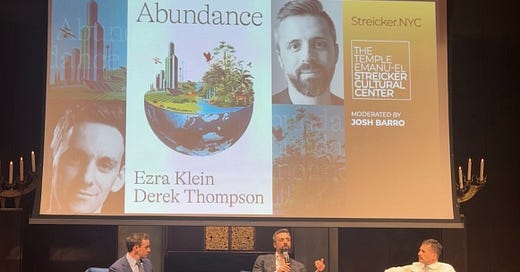Like many of you, we are excited about today’s release of Ezra Klein and Derek Thompson’s Abundance. Last night, we joined a packed room of “abundants” at Ezra and Derek’s book launch event. The energy was palpable; in a moment of federal chaos and local decay, New Yorkers are desperate for a new approach, and one with substance. They need an ideology to believe in, but also tangible benefits—the actual product of a “liberalism that builds.”
Klein and Thompson’s vision is remarkable. It has filled the ideological vacuum at the center of the Democratic party and inspired a nationwide coalition—of which we are proud to be a part—to rethink how we build and grow.
And yet, the authors cautioned against premature celebration. The ascendance of abundance an an idea—and the packed synagogue event space evincing its appeal—are just the first step towards a future with more than enough of everything we need.
Klein opened his remarks by discussing how, in California, YIMBYs have won “intellectual victory after intellectual victory after intellectual victory”—and yet housing is still being built at a snail’s pace. When asked which electeds he sees as abundance champions, he demurred. While it’s heartening to see electeds claiming the mantle of abundance, Klein wants to see how they navigate “real trade-offs” before giving anyone his seal of abundance approval.
Abundance (the book) isn’t itself a roadmap to abundance policymaking or powerbuilding. As the authors said, they are offering a vision, not an agenda; a “lens, not a list.” This is in part because of a key structural challenge: the policies that shape our cities—zoning reform, transit expansion, energy infrastructure—are overwhelmingly determined by state and municipal governments. The work of getting these policies passed, and electing leaders who will fight for them, is also local.
It is our job, then, to pick up where Klein and Thompson leave off.
From Lens to List
Building political power requires knowing what we’re fighting for. What would the specific planks of abundance policymaking look like in New York?
Thankfully, there is constellation of issue groups developing those policies; unfortunately, it’s not yet politically expedient for most elected officials to champion them. We believe that stitching these policies together across issue silos is one key to achieving them.
A core part of our work is coordinating a coalition of leaders across housing, transit, public space, and climate under a shared Abundance Agenda. These leaders are developing policy proposals, and our role is to knit them together—encouraging collaboration and cross-issue advocacy—into a whole greater than the sum of its parts.
Groups like Open New York, Open Plans, Riders Alliance, Transportation Alternatives, the New York League of Conservation Voters, and more have already laid out policy agendas they’re pushing at the city and state level this year. Key priorities include:
Faith-based Affordable Housing Act (FBAHA) to allow land-rich, cash-poor religious institutions to build needed housing in their communities
Universal daylighting to improve street safety in New York City
A clean fuel standard to reduce transportation emissions
Revising NYC’s charter to streamline and expedite ULURP processes
These are concrete steps we can take this year to advance a vision of abundance. But we’re also thinking beyond this legislative cycle. What does a medium-term abundance agenda look like? What policies should our next mayor be fighting for over the next 4-8 years?
Abundance begins by vividly describing a future with more than enough of everything we need to live affordable, vibrant, sustainable, flourishing lives. It’s incumbent on us to do the same for New York—to paint a picture for our policymakers and for future supporters of an Abundance Agenda.
From Policy to Power
The issue advocacy coalition provides the roadmap to an abundant future for New York, but how do we build the political coalition needed to unlock our progress down that path? That, too, is a highly localized project.
California provides a clarifying counterpoint: Last night’s event included much discussion about the archetypal “Marin progressive”—the person who claims to support environmentalism and inclusive cities but undermines both in practice through NIMBY votes and actions. In the Bay Area, the fight for housing abundance has largely aligned with the conflict between left and moderate factions: YIMBYs have found success by supporting a coalition of “mods” against the progressive left, driving both electoral and policy victories.
Here in New York, the alliances look different. The City Council’s Progressive Caucus was instrumental in passing City of Yes for Housing Opportunity, and some of our most effective pro-abundance communicators are on the left. Meanwhile, establishment Democrats, as a bloc, have not prioritized abundance—though we’re seeing promising signs from a few more moderate members.
Too often, we default to thinking about political conflict on a left-right spectrum (or in New York, a left-to-center-left spectrum). But we believe that abundance vs. scarcity is its own axis. NIMBYs exist across the ideological map; so do abundance champions. Unfortunately, to date those of us who want to restore New York’s dynamism and growth have been much less organized than those who want to preserve the status quo.
We’re here to change that—organizing a political community in support of the Abundance Agenda.
We’ll keep you updated on actions you can take and events you can attend to support the abundance policies we laid out above. In the meantime, let us know if you’d like to join a local or virtual Abundance book club to discuss Klein and Thompson’s ideas, and how we’re putting them into practice.






